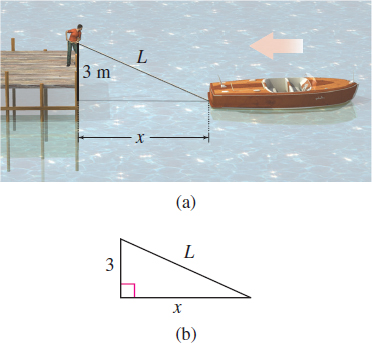EXAMPLE 4Solving a Related Rate Problem
A person standing at the end of a pier is docking a boat by pulling a rope at the rate of 2m/s. The end of the rope is 3m above water level. See Figure 5(a). How fast is the boat approaching the base of the pier when 5m of rope are left to pull in? (Assume the rope never sags, and that the rope is attached to the boat at water level.)
Solution
Step 1 Draw illustrations, like Figure 5, representing the problem. Label the sides of the triangle 3 and x, and label the hypotenuse of the triangle L.
Step 2 x is the distance (in meters) from the boat to the base of the pier, L is the length of the rope (in meters), and the distance between the water level and the person's hand is 3m. Both x and L are changing with respect to time, so dxdt is the rate at which the boat approaches the pier, and dLdt is the rate at which the rope is pulled in.
We are given dLdt=2m/s, and we seek dxdt when L=5m.
The Pythagorean Theorem is discussed in Appendix A.2, p. A-11.
Step 3 The lengths 3, x, and L are the sides of a right triangle and, by the Pythagorean Theorem, are related by the equation x2+32=L2
Step 4 We differentiate both sides of equation (2) with respect to t. 2xdxdt=2LdLdtdxdt=LxdLdt Solve for dxdt.
Step 5 When L=5, we use equation (2) to find x=4. Since dLdt=2, dxdt=54(2)L=5,x=4,dLdt=2dxdt=2.5
When 5m of rope are left to be pulled in, the boat is approaching the pier at the rate of 2.5m/s.
